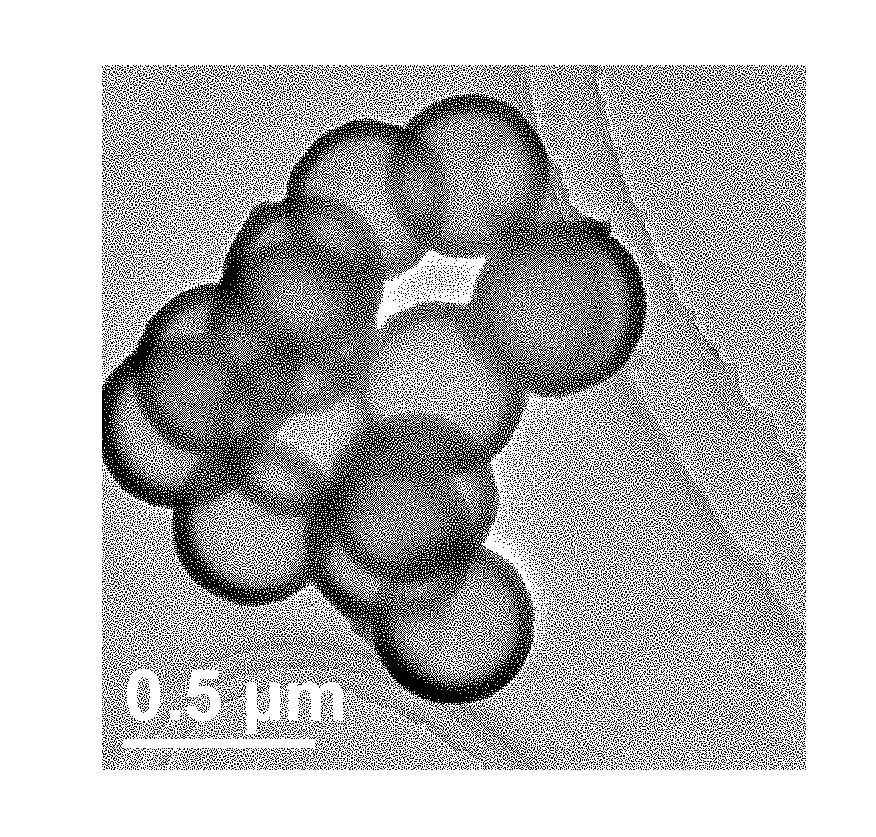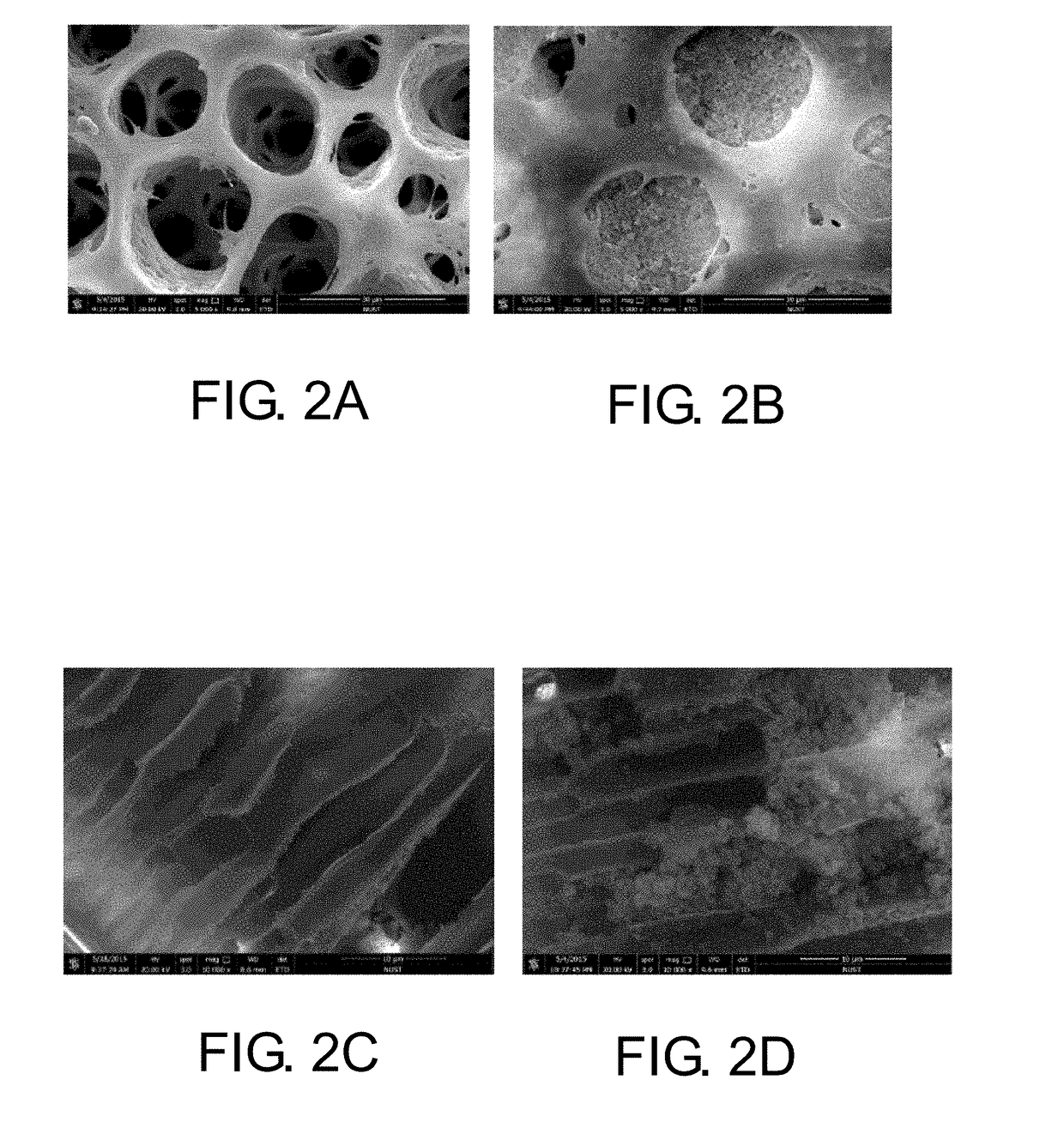Ultrafiltration membrane and a preparation method thereof
- Summary
- Abstract
- Description
- Claims
- Application Information
AI Technical Summary
Benefits of technology
Problems solved by technology
Method used
Image
Examples
embodiment 1
[0055]Step 1. Synthesis of Porous Hollow Nanoparticles
[0056]Porous hollow HZO particles were voted as the porous hollow nanoparticles model in the present embodiment.
[0057]The preparation of porous hollow HZO particles comprised four steps. (1) to prepare SiO2 particles, 18 mL concentrated ammonia and 49.5 mL water were added to 32.5 mL ethanol. After stirring for 30 min, a mixture of 9 mL tetraethoxysilane and 91 mL absolute alcohol was added. The reaction mixture was further stirred for 8 h. The resultant colloids were centrifuged, fully washed with distilled water and alcohol for three times, and then redispersed in 320 mL absolute ethanol; (2) 1.0 mL distilled water and 0.75 g Brij-35 were added into the above obtained solution and stirred for 2 h before a mixture of 4.5 mL Zirconium n-butoxide and 45.5 mL absolute alcohol were added. The reaction mixture was stirred for another 8 h before the products were collected through centrifugation and redispersed in water (50 mL). After...
embodiment 2
[0071]Step 1. Synthesis of Porous Hollow Nanoparticles
[0072]Porous hollow carbon particles were voted as the porous hollow nanoparticles model in the present embodiment.
[0073]1.04 g CTAC (25 wt %) was added to a mixed solution of 19 mL distilled water, 0.1 mL aqueous ammonia and 5 mL anhydrate alcohol, and the mixture was stirred for 30 min. Then, 0.2 g m-dihydroxybenzene was added and stirred for 30 min. After that, 0.72 mL tetraethoxysilane and 0.28 mL formaldehyde were added and stirred for 24 h at 30° C. After the reaction was completed, solids were recovered by centrifugation and air-dried at 80° C. for 12 hours. The dried solid was calcined in nitrogen, at 200° C., 350° C., 500° C. and 600° C. for 2 hours, respectively, and then continued to be calcined at 800° C. for 5 hours. Finally, porous hollow carbon particles were obtained. In the present embodiment, a large number of hollow-structured spherical particles with the sizes of 200˜300 nm were produced.
[0074]Step 2. Preparat...
embodiment 3
[0083]Step 1. Synthesis of Porous Hollow Nanoparticles
[0084]Porous hollow ferroferric oxide particles are voted as the porous hollow nanoparticles model in the present embodiment.
[0085]The porous hollow ferroferric oxide particles were synthesized by a one-step hydrothermal method. 2 nunol ferric chloride, 4 mmol sodium citrate and 6 mmol urea were dissolved in 40 mL, and then 0.3 g of polyacrylamide was added into the above mixture. The mixture solution was stirred until the PAM was completely dissolved. The solution was then sealed in Tefionlined stainless-steel autoclave and reacted at 200° C. for 12 h. Afterwards, the resulting solution was cooled to room temperature. Black solids were collected and washed with water and absolute ethanol in turns. The porous hollow ferroferric oxide particles were obtained after vacuum drying. In the present embodiment, a large number of porous hollow ferroferric oxide particles with the sizes of 200˜300 nm were produced.
[0086]Step 2. Preparatio...
PUM
| Property | Measurement | Unit |
|---|---|---|
| Temperature | aaaaa | aaaaa |
| Fraction | aaaaa | aaaaa |
| Fraction | aaaaa | aaaaa |
Abstract
Description
Claims
Application Information
 Login to View More
Login to View More - R&D
- Intellectual Property
- Life Sciences
- Materials
- Tech Scout
- Unparalleled Data Quality
- Higher Quality Content
- 60% Fewer Hallucinations
Browse by: Latest US Patents, China's latest patents, Technical Efficacy Thesaurus, Application Domain, Technology Topic, Popular Technical Reports.
© 2025 PatSnap. All rights reserved.Legal|Privacy policy|Modern Slavery Act Transparency Statement|Sitemap|About US| Contact US: help@patsnap.com



